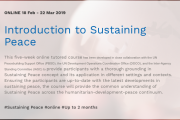Sustaining Peace
In April 2016, the United Nations General Assembly and the Security Council adopted the landmark resolutions on peacebuilding: (A/RES/70/262) and (S/RES/2282). The Sustaining Peace Resolutions were negotiated in response to the findings of three major reviews of the UN’s peace operations, peacebuilding architecture, and women, peace, and security activities in 2015.
An important breakthrough in the twin resolutions is the recognition that efforts to sustain peace are necessary not only once conflict has broken out, but also long beforehand, by addressing root causes to prevent “the outbreak, escalation, continuation and recurrence of conflict”. The term “sustaining peace,” therefore builds on and expands the concept of post-conflcit peacebuilding. It refocuses the UN’s work in the area of peace and security to include proactive measures aimed at strengthening peace where it already exists by reinforcing the structures, institutions and social meshanisms that underpin it. In doing so, this new approach seeks to render all of the UN’s current and future work on peace and security more effective.
In the resolutions, Member States recognize that sustaining peace is a shared task and reaffirm the primary responsibility of national Governments and authorities in identifying, driving and directing priorities, strategies and activities for sustaining peace. The resolutions therefore call for closer strategic and operational partnerships among governments, the UN and other key stakeholders. Underscoring the importance of women’s leadership and participation in preventing and resolving conflict, the resolutions also stress the need to promote gender dimensions of sustaining peace. The resolutions further call upon Member States to increase meaningful and inclusive participation of young people in these efforts.
Operationalizing Sustaining Peace
The Secretary-General has identified prevention as his highest priority and is overseeing system-wide efforts to re-orient the UN towards this goal. By placing prevention at the center of the sustaining peace resolutions, Member States recognised that preventing violent conflict goes beyond short-term solutions and requires a broader view than only post-conflict reconstruction. Sustaining peace and conflict prevention require targeted investment in remedying structural issues that drive conflict. From a development perspective, this means addressing exclusion, injustice, inequality, corruption.
The Secretary-General is tasked with spearheading the implementation of the sutaining peace resolutions. His Report on Peacebuilding and Sustaining Peace (A/72/707-S/2018/43), released in February 2018, elaborates on his vision to enhance United Nations' policy and operational coherence to support peacebuilding and sustaining peace. The central message of the report is that "an ecosystem of partners working in support of governments is critical for sustaining peace". The Secretary-Generall therefore calls for strengthening partnerships at every stage along the peace continuum, from conflict prevention and resolution to peacekeeping, peacebuilding and long-term development. It placees even greater emphasis on national ownership and supporting national actors to develop the national capacities needed to address structural inequalities, exclusion, and other factors that undermine social cohesion, and if neglected, may lead to violent conflict. One of the ways to do this is through undertaking joint analysis and effective strategic planning across the United Nations system.
"Sustaining
peace will only be realized through committed, inclusive national
ownership that considers the needs of the most marginalized, including
women, young people, minorities and people with disabilities."
— UN
Secretary-General António Guterres, Remarks to the General Assembly
high-level meeting on peacebuilding and sustaining peace, 24 April 2018.
The UN’s approach to sustaining peace will unfold simultaneously across several dimensions. First, it shifts the primary agency for sustaining peace from the international to the national and local level. Second, it broadens the institutional responsibility for peace to the whole UN system by leveraging the three pillars of UN engagement—peace and security, development, and human rights, in addition to humanitarian action —, to generate sustaining peace outcomes. Current efforts to strengthen coherence across humanitarian, development and peace activities, and the focus on the nexus of these sectors, are therefore critical to sustaining peace. And third, it switches the focus of the UN from its current emphasis on re-active capacities to a pro-active approach to responding to emerging risks of violent conflict.
As part of ongoing management, development, and peace and security reforms initiatives within the Organization, the Secretary-General is committed to put in place the leadership, management, coordination, planning, and funding instruments necessary to ensure that all dimensions of sustaining peace are integrated and aligned to generate a whole-of-UN approach.
Linkages between Sustaining Peace and the SDGs
The concept of sustaining peace was informed and inspired by Agenda 2030 for Sustainable Development and the 17 Sustainable Development Goals (SDGs).
The universality of the 2030 Agenda, its emphasis on prevention and its pledge to leave no one behind makes sustainable development central to the implementation of the sustaining peace resolutions. SDG 16 explicitly aims at building peaceful, just and inclusive societies. Under this goal 12 targets spell out the means by which national governments and societies and the international community are to achieve it, including by promoting the rule of law and access to justice, reducing corruption, developing effective and accountable institutions, and ensuring access to information. While such measures clearly contribute to preventing conflict and sustaining peace, the SDGs emphasis on inclusion, access and a rights-based approach make the whole of Agenda 2030 directly relevant to sustaining peace, and vice versa.


